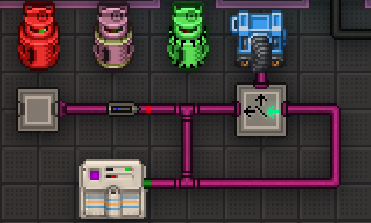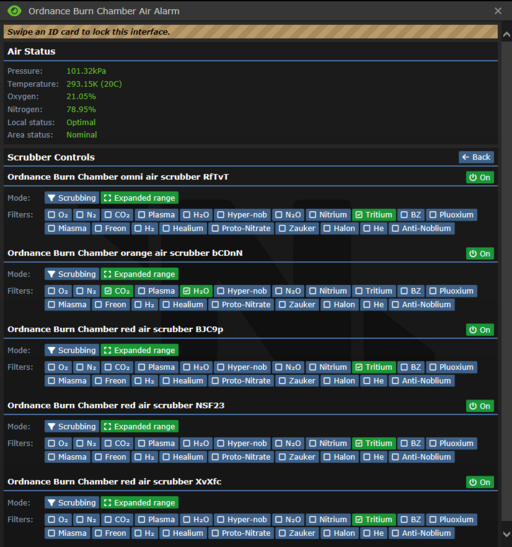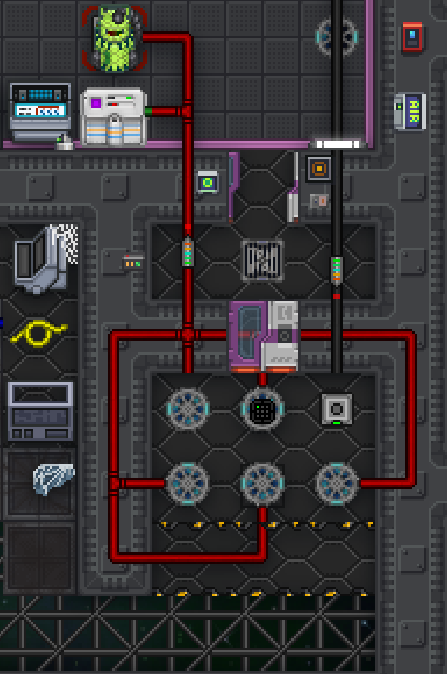Guide to toxins
Assigned to:Neok
Experiments
There are currently 9 experiments you can complete with help of the toxins lab, which can all be found by downloading the NT frontier app on your tablet or modular computer. Completing any of these experiments rewards you with research points, as well as money for the department funds. The exact amount depends on the tier and partner selected, higher tiers reward more, and some partners will reward more funding, while others will reward more points. Finally, some tech options are heavily discounted when completing certain experiments:
- BZ Gas Shells Provides a 10 000 point discount on Advanced engineering
- Hyper-Noblium Gas shells Provides a 10 000 point discount Quantum Electromagnetic Technology
- Reactionless Explosives Provides a 10 000 point discount on weapon development technology
NT Frontier
NT Frontier is an application found on the purple disk in the ordnance lab, as well as on the software hub. This applicaiton is used to publish papers, see which papers have already been published, and see which experiments are available and what their requirements are. To publish a paper, you first need a data file gathered by either the tank compressor, or tachyon-doppler array. Once you have downloaded a data file from a portable disk, you can use the "publish papers" tab to complete one of the available experiments. First fill out all the empty boxes with a relevant titel, your name, and and optionally an abstract of what you did (or just fill in random nonsense). Next select your data file, and the type and tier of experiment you want to complete, followed by which partner you wish to publish it too. Publishing a paper rewards science with research points, credits for the budget, and any related discounts. The exact reward depends on the type and tier of the experiment, and which partner was chosen.
Tank Compressor
The tank compressor, found in the toxins launch room, is the device used for Gas Shell type experiments, as well as compressing hot gas into a tank above what the release valve on a canister can achieve. This device has an input port for the gasses that will be compressed into the tank, a slot inside of it for the tank you wish to fill, and an output gas for retrieving any of the gasses inside of the tank at the moment it ruptures. When using the tank compressor for gas shell experiments, you will want to rapidly pump in gas to the tank to the point the tank either starts leaking, or fails dramatically and explodes. In the case of the former happening, the compressor will indicate a LEAK HAZARD and the tank will slowly drain its contents, removal of the tank will make the experiment data availalbe, but removal before it is empty will result in the contents being freed into the room. If the tank explodes, it will simply cease to exist, and the experiment data will become available in the second tab of the machine. When using the machine to compress gas for use in explosive tests, take care not to exceed 2600 kPa, or the tank will become stuck in the machine.
Tachyon-Doppler Array
The Tachyon-Doppler Array records the specifics of any explosion in front of it, spitting out a wall of text as well as producing a data file for use in NT frontier. The array will give the theoretical size of an explosion, which is value used in NT Frontier. The array also notes the possible cause(s) of the explosion, which decides for which experiment the data is eligble.
 Anomaly Refinery
Anomaly Refinery
The Anomaly refinery, found in the toxins launch room, is used to refine raw anomaly cores into their usable counterpart. To refine a core, simply put the raw core in the machine with a tank transfer valve bomb and press the implode button, the size of the required explosion starts at 4, and increases with each core of the same type you refine. This machine can also be used to simulate exploding a TTV without actually doing it, making it useful for improving your bomb mixes.
Other tools of the trade
See also:
 Atmospherics items
Atmospherics items
Creating gasses, ordnance edition
BZ Formation
For both the BZ Gas shell experiment and for the efficient formation of hyper-noblium, you will need BZ Gas. Thankfully, the ordnance lab comes equipped with a freezer chamber suited to do just this. BZ is the product of a reaction between two mol of plasma and one mol of nitrous oxide, this reaction happens fastest at lower pressures. We will modify the freezer chamber to be fed directly by a gas mixer, fed by one plasma canister, and one nitrous oxide canister. The node with the plasma canister should be set 67%, leaving the other node at 33%, the pressure should be maximized. Next, use the unlocked air alarm on the freezer chamber wall to set the scrubber inside of the chamber to scrub BZ at extended range, and turn it on. Lastly, connect a CO2 or Plasma canister to the cooling port on the side off the freezer, and turn on the thermomachine at the lowest temperature. To start the formation, use the computer console, select the freezer chamber, and change the input to 1l/s before turning it on. The plasma/nitrous oxide mixture will now trickle in, slowly forming BZ, connect a canister or small pump to the output to collect your finished BZ.
Tritium
A number of experiments require tritium. Tritium is created by reacting oxygen and plasma at a ratio above 97:1 (preferably as high as possible). To do this we will use the burn chamber convienently provided to us in the ordnance mixing chamber.
Initial Piping
Leave the input loop (black loop on the bottom left) alone, as it suits our needs for now. Modify the the red (output) loop by adding a cooler to it, you can move a cooler by screwing the panel open and then right clicking it with a wrench, left click rotates the cooler. Also add a connector and an empty, shielded canister. Next acquire a firesuit, open the outer doors blast doors to expose space, and enter the airlock. Important note: opening the chamber to space and adding this orange loop helps efficiency, but you'll take damage because of the cold, drink coffee or skip this step to prevent this. Additionally, make sure to turn off the scrubber on icebox before opening the blast doors, to prevent co2 from entering the loop from outside . Add three additional scrubbers to the red loop. Lastly, add a fourth scrubber facing to space, and connect it to a passive vent in space (Shown in orange). You may need to walk around the outside of the burn chamber to connect all the scrubbers, once this is done head back inside.
Use the air alarm next to the burn chamber, and set all scrubbers to extended range. Set the scrubbers connected to the red line to scrub tritium, and turn them all on. Set the orange scrubber connected to space to scrub H2O and CO2, and turn it on.
Next, maximise the red output pump, and turn the input pipe to 500 kPA (you can experiment with this pressure to see what gives you the best yield) and turn both pumps on. Move over to the large oxygen tank, and add a plasma canister onto one of the mixers, initially set this mixer to take 5% from the side node, we will increase this number up to 40% as the burn progresses. Turn on both mixers at 4500kPa, and set the mixer not in use to take 100% from the main node. Open all the valves on the way to the burn chamber, and double check if you've missed anything before you start the burn.
Tritium production
Now that the chamber is ready, you can use the control console to turn on the injector at 200l/s. Make sure to hit the igniter button on the side of the chamber to start the reaction, then move to the console to monitor the burn. The plasma present in the chamber will quickly burn off, leaving a low concentration (below 1%) in the burn chamber. At this point, tritium will start forming and you can move back to the gas mixer to increase the amount of plasma in the mixture to 40%. You should see the pressure and amount of mol in the output canister slowly go up as the burn goes on. If you are not statisfied with the amount of tiritum produced, simply replace the plasma canister as it starts to run out.
Noblium Gas shells
Noblium is a gas created by mixing nitrogen and tritium at under 15 kelvin. This reaction creates a large amount of heat, which can be reduced by adding BZ (BZ will not be consumed if used in this way). Cool down one tank of nitrogen to the same temperature as your tritium (30 kelving if you followed the tritium guide), for ease of mixing. Now clear an area and construct a new loop, Connect this loop to a cooler, add one volume pump with a connector for adding BZ, add one filter that connects to a canister, and pumps the rest back into the loop, lastly add a gas mixer with two connector ports leading into the loop. You will want to configure the filter to remove hyper-noblium, and add a T2 canister to the connector. Next add your BZ canister, and very carefully add around 20-30 mol of BZ into the loop (I recommend setting the pump to 5 l/s or lower). Add your nitrogen to node one on the mixer, and your tritium to node two. Set the mix on the mixer to 66.7% nitrogen, and 33.3% tritium. You only to pump in this mixture untill you have usedaround 50-100 mol of tritium, as that will create enough noblium for the gas shell experiment and leave you with enough to complete nitrium gas shells. Once you are satisfied with the amount of hyper-noblium, cool down your canister, and then transfer all the gas into a small pump and finally into an empty tank to be used in the compressor. Pipe in some random gas to explode the tank, and publish your paper!

Reactionless Explosives
Reactionless explosives depend on a difference in heat capacity of two different types of gasses in separate tanks. One tank is filled with a hot gas with a high heat capactiy, while the other is filled with a cold gas with a low heat capacity. When the contents are mixed by opening a tank transfer valve, the temperature between these gasses equalizes, but the amount of energy needed to heat up the cold gas is far smaller than the amount of energy needed to lower the temperature of the hot gas, resulting in a very high end temperature, this in turn causes a high pressure and an explosion.
To achieve this, we can simply transfer oxygen or nitrogen into a portable pump, which we then cool and pump into a tank, making up the cold portion of our bomb. Oxygen and nitrogen work fine for this, although the highest tier of this experiment is only achievable with Anti-Noblium. For the hot part of the mixture we first need a source of energy, to this end, we use a gas mixer to fill an empty canister with 70% plasma, and 30% oxygen, higher pressures will achieve higher end temperatures, but only slightly changes in explosive radius, so we will only pressurize the canister to 1000 kPa. Next, make sure to shield the burn mixture canister, before heating it to at least 474.15 kelvin with a thermomachine, and then disconnect it. This mixture in this "sun can" will slowly burn up, increasing the temperature of the canister. While waiting for the sun can to finish burning, fill another canister with approximately 5 mol of either plasma, or hyper-noblium for the best results, do not forget to shield this can either. Use your RPD to connect two connectors with a heat transfer pump, and proceed to use it to transfer the thermal energy of our sun can into our new canister. To put our hot gas into a handheld tank for our bomb, you can either directly connect it to the canister, or use the tank compressor to reach a much higher pressure, just make sure to reconstruct the tank compressor beforehand to flush its internal gas buffer.
Now simply construct a bomb from these two tanks using a tank transfer valve, and acidentally blow yourself up reap the results.

